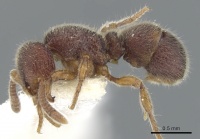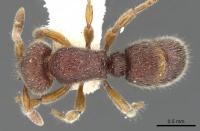Proceratium angulinode
| Proceratium angulinode | |
|---|---|

| |
| Scientific classification | |
| Kingdom: | Animalia |
| Phylum: | Arthropoda |
| Class: | Insecta |
| Order: | Hymenoptera |
| Family: | Formicidae |
| Subfamily: | Proceratiinae |
| Tribe: | Proceratiini |
| Genus: | Proceratium |
| Species: | P. angulinode |
| Binomial name | |
| Proceratium angulinode De Andrade, 2003 | |
Nothing is known about the biology of Proceratium angulinode.
Identification
Proceratium angulinode and Proceratium striativenter are very distinctive among the species of the silaceum clade. Both species share by synapomorphy the postpetiole antesolaterally angulate and the first gastral tergite with a transversal integumental folding before the posterior margin. angulinode differs from striativenter, in the worker, by the broader frontal carinae, by the SI < 65 instead of ≥ 75.6, by the gaster with thinner and shorter longitudinal rugosities and by the TL < 2.9 mm instead of > 3.3 mm.
Keys including this Species
Distribution
Known only from Sarawak, Malaysia.
Distribution based on Regional Taxon Lists
Indo-Australian Region: Borneo (type locality), Indonesia, Malaysia.
Distribution based on AntMaps
Distribution based on AntWeb specimens
Check data from AntWeb
Countries Occupied
| Number of countries occupied by this species based on AntWiki Regional Taxon Lists. In general, fewer countries occupied indicates a narrower range, while more countries indicates a more widespread species. |

|
Estimated Abundance
| Relative abundance based on number of AntMaps records per species (this species within the purple bar). Fewer records (to the left) indicates a less abundant/encountered species while more records (to the right) indicates more abundant/encountered species. |

|
Biology
Castes
Nomenclature
The following information is derived from Barry Bolton's Online Catalogue of the Ants of the World.
- angulinode. Proceratium angulinode De Andrade, in Baroni Urbani & De Andrade, 2003b: 375, fig. 146 (w.) BORNEO (East Malaysia: Sarawak).
- Type-material: holotype worker.
- Type-locality: Malaysia: Sarawak, 4th Divison, Gn. Mulu Nat. Park, v.-viii.1978, BM 1978-49 (P.M. Hammond & J. Marshall).
- Type-depository: BMNH.
- Status as species: Pfeiffer, et al. 2011: 57.
- Distribution: Malaysia (Sarawak).
Unless otherwise noted the text for the remainder of this section is reported from the publication that includes the original description.
Description
Worker
Head about as broad as long and with the sides gently diverging posteriorly. Vertex in full face view gently convex. Clypeus reduced and slightly surpassing the antennal sockets. Anterior border of the clypeus truncate. Frontal carinae far from each other, partially covering the antennal insertions. Lateral expansions of the frontal carinae broad, little raised, strongly diverging on the anterior one-half, converging on the third fourth, parallel and carinate only on the last fourth. Frontal area gently concave on the three anterior fourths and with a central, thick longitudinal carina starting from the last fourth and prolonging posteriorly. Head anterolaterally with a thick, short, longitudinal carina. Genal carinae marked, each carina corresponding to the external border of a deep sulcus. Eyes visible as a small dark dot below the integument, on the middle of the head sides. First funicular joint about as long as broad. Funicular joints 2-10 broader than long. Last funicular joint as long as the sum of joints 6-10. Scapes short of the vertexal margin and gently thickening apically. Masticatory margin of the mandibles with 6-7 denticles before the pointed apical tooth. Palp formula 2,2.
Mesosoma in side view gently convex and about as long as the maximum head length (mandibles included). Pronotal and propodeal sutures absent. Basal face of the propodeum declivous posteriorly. Declivous face of the propodeum flat. Area between the basal and declivous faces of the propodeum weakly concave, irregularly marginate, the margin forming a triangular denticle or an angle laterally. Sides of the declivous face of the propodeum marginate. Propodeal spiracle round and above mid height in lateral view.
Petiole subrectangular and thick. Anterior border of the petiole straight and anterolaterally carinate. Ventral process of the petiole large, stout and triangular. Anterior face of the postpetiole concave and laterally strongly angulate. Postpetiolar sternite anteroinedially with a marked subtriangular projection, gently convex posteriorly in side view. Constriction between postpetiole and gaster impressed. Gastral tergite I about 1/4 longer than the postpetiole and convex on the curvature. Gastral tergite I with a thick, irregular, transversal border before the posterior margin, the border almost as long as the posterior margin. Remaining gastral tergites and sternites curved ventrally.
Legs short. All tibiae with a pectinate spur. Spurs of fore legs without basal spine. Fore basitarsi longer than the mid ones. Hind basitarsi about 1/3 shorter than hind tibiae. Second tarsomere of hind legs slightly shorter than pretarsus. Pretarsal claws simple. Arolia absent.
Sculpture. Head, mesosoma, petiole, postpetiole and gaster with variably distributed, irregular, foveae-like impressions, granulopunctate and irregularly rugulose. The granules less raised and the rugosities slightly longitudinal on the gaster. Legs punctate.
Body covered by hairs of three main types: (1) short, dense, suberect or subdecumbent on the whole body, sparse on the funicular joints; (2) longer than type (1), erect on the whole body, slightly shorter on the scapes, absent on the funiculi; (3) shorter than hair type (1), dense and decumbent on the funicular joints. In addition the funicular joints bear whitish, thick, appressed, sparse hairs.
Colour. Dark ferrugineous-brown with lighter antennae and legs.
Measurements in mm and Indices: TL 2.76-2.85; HL 0.62-0.65; HW 0.62-0.66; EL 0.04; SL 0.40-0.41; WL 0.80-0.84; PeL 0.22; PeW 0.33-0.34; HFeL 0.45-0.47; HTiL 0.38-0.39; HBaL 0.26; LS4 0.24-0.25; LT4 0.55-0.57; CI 100.0- 101.5; SI 63.1-64.5; IGR 0.44.
Type Material
Holotype worker (unique) from Malaysia labeled: "Sarawak: 4th Division Gn. Mulu NP., P. M. Hammond & J. E. Marshall, v-viii.1978, B.M. 1978-49", in The Natural History Museum.
Etymology
From the Latin angulus (= angle) and norius (= pedicel), referred to the postpetiole, anterolaterally angulate.
References
- Baroni Urbani, C., de Andrade, M.L. 2003. The ant genus Proceratium in the extant and fossil record (Hymenoptera: Formicidae). Museo Regionale di Scienze Naturali, Monografie, 36, 1–492. (page 375, fig. 146 worker described )
References based on Global Ant Biodiversity Informatics
- Baroni Urbani C., and M.L de Andrade. 2003. The ant genus Proceratium in the extant and fossil record (Hymenoptera: Formicidae). Museo Regionale di Scienze Naturali, Monografie 36: 1-480.
- Pfeiffer M.; Mezger, D.; Hosoishi, S.; Bakhtiar, E. Y.; Kohout, R. J. 2011. The Formicidae of Borneo (Insecta: Hymenoptera): a preliminary species list. Asian Myrmecology 4:9-58

